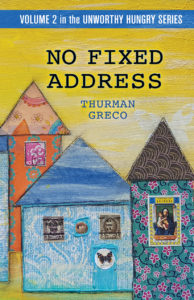September 20, 2019 at 10:24 am
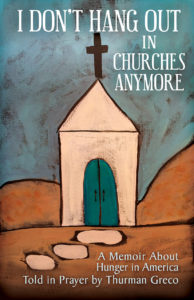
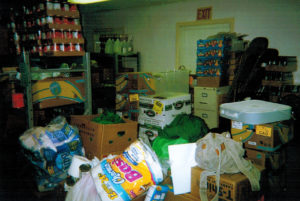
Like many first-time pantry volunteers everywhere, I showed up that morning because someone from the church asked me to come. A slot needed to be filled and I stepped up to the plate when I was asked. I was a foot soldier in the army of the outreach. I tried to live up to my status in the church as a new member. I showed up at whatever activity needed help and did my share. Nothing more.
I had no desire to move up any ladder in the congregation.
On that morning of new beginnings, I had no premonition I would ever return to this pantry room.
I had no plans for this place in my future. I had a profession teaching reflexology, Reiki, and canine massage therapy in a healing space in my home on Tannery Brook.
This was a case of fools rushing. Knowing what I know now, I should have run out the door and never looked back. Mary could have handled the crowd that day without me. In the whole two hours, no more than a couple dozen people visited the pantry.
I wasn’t blessed with any psychic knowledge…certainly not the feeling of danger I felt when I saw the head of the building committee in the hallway outside the pantry months later.
There were no lines in the hallway at the new beginnings of my time there. People wandered into the pantry in groups of one and two to choose from cereal, soup, tuna, and peanut butter.
Never in my wildest thoughts on that day did I envision the pantry hallway filled with hungry people, the tiny room packed with fresh produce and jammed with shoppers.
By 2008, the tanked economy was well underway and waits in the hallway were an hour or more.
The Hunger Prevention Nutrition Assistance Program (HPNAP) passed down feeding guidelines which included whole-grain bread, 1% milk, fresh produce. By 2011, the building committee had rules dictating where people could stand, what bathroom they could use, and what parts of the hallway were off-bounds.
Never did I foresee monthly food deliveries averaging over 12,000 pounds.
Never did I imagine, on that day, building committee members angry over hungry people receiving food according to guidelines set down by the State of New York, the Department of Health, and the United States Department of Agriculture.
I never thought I would spend months grappling with the unworthy hungry, a concept introduced to me by a local religious leader. The concept wasn’t explained. Only the two words – unworthy hungry – were used in a sentence: “You are feeding the unworthy hungry.” This was something I never heard of before. What did she mean? Who were the unworthy hungry?
After that first morning in the food pantry, I drove home, pulled out a little notebook from a drawer and wrote what people said, like real writers do. When I wrote these things down, I felt my grandmother’s presence.
Her spirit was with me in the room. I looked around the dining area to see if someone had entered the room without my realizing it. But, no, I didn’t find a soul. I walked over to a cabinet and began my dialogue journal on that afternoon.
A shopper: “They cut my food stamps again. I don’t know how I’m going to make it. I have no money this month. My car died and I don’t know where I’m going to get money to fix it. If I can’t fix it, I can’t buy a new one either.”
Lillie Dale Cox Thurman spoke to me clearly that morning with emphatic, strong, direct instructions. She went straight to my head: “Write this down! Write this down too! Now…write this down.”
My grandmother, Lillie Dale Cox Thurman, stepped into my life on the first morning in the food pantry and never left. Not even when my mother, Uralee Thurman Lawrence, roared in with prayers and fast, furious, aggressive instructions which I resisted to the bitter end. Under their directions, I joined the crowd in the basement and was soon volunteering regularly.
So, now, I’ve got the second volume, “The Ketchup Sandwich Chronicles,” coming out on this blog.
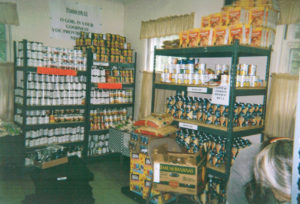
Thank you for reading this blogged book! Please refer it to your preferred social media network and stay tuned for future chapters!
Thurman Greco
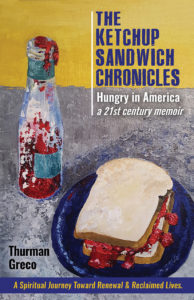
September 18, 2019 at 4:46 pm
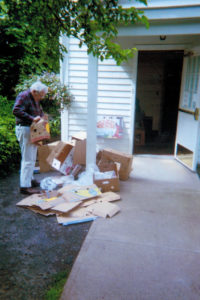
Part 1
I began this memoir before I even knew it. On the first day I worked in the basement food pantry, I sat with Mary, a member of St. Gregory’s Episcopal Church and the head of the alter society. We greeted a couple dozen hungry people. Mostly single homeless men, there were a few of Woodstock’s famous colorful characters included in the mix that day.
Throughout my career in the pantry, the most colorful of the colorful was Grandpa Woodstock who liked to bring his bride, Lady Estar into the pantry to shop. The two of them went around the room choosing from peanut butter, cereal, tuna fish, and soup. While this happened, he entertained us gushing enthusiastically.
“My, how beautiful you look today!” I fell for his spiel every pantry day. Those words melted my heart. The most professional of the street actors, he knew how to make us each feel special when he flashed his peace sign and posed for photographs. Grandpa knew how to flash that peace sign, whip out his postcards to sell, and sound off his horn “toot toot”. I sometimes thought he spent a few afternoons posing in front of a mirror to figure out how to get the best response from tourists.
Grandpa Woodstock and Lady Estar were most photogenic with their long, flowing silver hair. Their lovely matching beards only emphasized floral print silk skirts and kimonos. Their toenails were painted matching colors and their Teva sandals matched.
None of Woodstock’s rich and famous got so many requests for autographs and photographs. They simply couldn’t compete with his show off tricks.
After all, Grandpa entertained us all with street theater at its finest. So what if he didn’t mean a word of it? We all enjoyed being sucked into the show!

 Thank you for reading this article. Please refer it to your preferred social media network.
Thank you for reading this article. Please refer it to your preferred social media network.
Thurman Greco

September 18, 2019 at 1:14 pm
The first time I ever saw a child begging for food was in Mexico. I was on a car trip going through Monterrey on the way to visit my future in-laws in Mexico City. When we parked the car in front of a restaurant, children immediately surrounded the vehicle. Small children held their hands out, asking for money for food. Each held up little brown palms. Their pleading faces looked into my eyes.
At that time, I didn’t yet speak any Spanish, but I didn’t need a vocabulary beyond English to understand the situation. Their body language spoke of expectations, hope and hunger.
“Don’t worry yourself about this Coit. They’re just after a few pesos.” My soon-to-be husband tried to comfort me. In my heart I knew different. The child we discussed was about the size of a thin eight-year-old. Teeth don’t lie though. He had a mouth full of adult teeth. That put his age at about twelve years.
In Mexico, children dig through trash for food. And, nine years after this road trip, in Mexico City, a beautiful young Indian woman standing on a corner tried to sell her infant. She approached my church friends first, an American couple in Mexico City on a study visa. Bob and Sue felt they couldn’t get the baby over the border when they returned to the U.S. at the end of their class. I wasn’t a good candidate because, at the time we discussed the baby, I was still married, had no visa or citizenship papers, and didn’t feel I was ever going to cross back over the river heading North.
Whatever happened to that beautiful baby? Whatever happened to her desperate mother? I’ll never know.
You want to talk hunger, then let’s discuss Venezuela and Mexico for a while. Even now, years later, I remember each encounter with a hungry person or household as if it happened only yesterday. I’ll never forget those people, the look of hunger in their eyes.
When people wanted to talk to me about hunger in America, it was a nonissue. Hunger in America? Whoever heard of such a thing?
Hunger has been with us in this country since the beginning. Famous American history stories include Pilgrims starving over the first winter in their new home. The stories of Mormons starving when they headed west are just two. These stories are different from segments of our population going to bed hungry because there isn’t enough money for food.
Even though I’m the loudest mouth in the crowd when I talk about hungry people in America, I’ve never seen hungry children begging for food when I park my car outside a store or restaurant.
Somehow, in this country, hungry people keep themselves hidden unless they are in the food pantry or soup kitchen line.
I lived in both of those places. I could talk hunger with you “until the cows come home,” as my grandmother said. But America? “Fuggedaboutit,” as I heard someone say once on a Brooklyn bus tour.
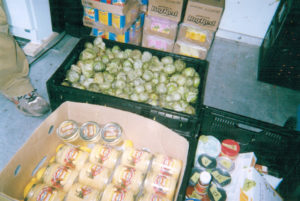
Thank you for reading this blog post. It is an excerpt from “The Ketchup Sandwich Chronicles”. I’ll be posting more stories from this book in the coming days.
I hope you enjoy them. If so, please refer the posts to your favorite social media network.
But, whether you refer them or not, I thank you for reading this story.
Thurman Greco


September 16, 2019 at 9:05 pm

Writing this blog post was risky. In the early days I worried about peoples’ opinions. I wrote my first blog entries with skeptics in mind. On some level it was important to me for pantry deniers to understand that there are, indeed, hungry people around us
One day I saw clearly that some people aren’t going to like me or my work. Nor are they going to believe what I write, no matter what I say. Once I realized that truth, I knew I’d been wasting energy on other people’s opinions.
I’m no longer interested in convincing anyone about what it means to go to bed hungry.
I’m okay with people saying anything about me because I know the chapters I write are true. The words I write make a difference in peoples’ lives.
This blog is about people creating better lives for themselves while not having enough to eat and lacking proper healthcare, housing.
This blog is about healing and creating new opportunities in one’s life. This blog is about people changing their lives – against all odds.
While I tell this story, I know some people won’t believe a word. It’s okay. I have my story and they have their story.
Food and sex and money are three words and issues more concerned with a person’s core beliefs, emotions, and spiritual attitudes than anything else.
These three words offer rules for everyone. We each have core beliefs around them with opinions about what is okay and what isn’t okay. We have attitudes about food, sex, and money based on what we were taught by family members and peers when we were children. We live our lives based on those experiences. Reduced to their lowest common denominator, these words – food, sex, and money – are the same. They touch core beliefs in ways going straight to the heart and soul.
The food pantry was all about food and money. The sex part was limited, but still there. Sex happened in the pantry hallway line when a shopper suffering with mental illness, a handsome young man who lived in another world, masturbated in the food line.
Our attitudes, opinions, feelings about feeding hungry people are or are not based on facts, statistics, or reality. Nor will facts, statistics, information, change attitudes.
Finally, we all have beliefs about who it’s okay to feed and who it’s not okay to feed. My beliefs are based on life experiences, facts, statistics. Their beliefs are based on the same. I may have taken classes, gone to therapy. And, they may have also.
Their reality about what is okay and my reality about what is okay differ.
In the food pantry hallway, we all looked at the same people and saw different things. This situation is proof positive we each create our own reality about hungry people. Nothing changes either reality. We each see hungry people through lenses shaped by separate life experiences. Hungry people don’t live in two realities.
As the lines got longer, we looked at people in the line. I saw hungry people and they didn’t. I interacted with people weekly who dumpster-dived to feed themselves as well as their children, parents, housemates. Occasionally I read articles about the ethics of dumpster diving. I didn’t think we could explore the ethics of allowing people go hungry because they couldn’t make enough money at their jobs to buy the food they needed to live and work.
People coming to a food pantry can take a three-day-supply of food home each week. The other four days, they’re on their own. That means they can buy more food if they have a SNAP card and if they can get to a store selling food. If they don’t have the money or a SNAP card, they get creative or go hungry. This involves panhandleing, borrowing money or food from friends, relatives, neighbors. They can steal, dumpster-dive, drop in at someone’s house at mealtime, and skip meals.
“Thurman is out of control over at the food pantry” described the local vicar because of the number of people shopping at the pantry and the amount of food they took home.
Thank you for reading this blog post. Please refer it to your favorite social media network.
Thurman Greco


August 29, 2019 at 12:25 am
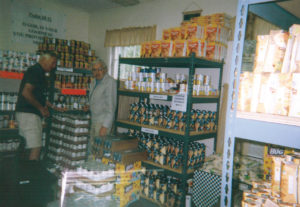
Your vacation time is here! It’s your last chance to get a break this summer. That means it’s time to go to the beach – to the mountains – to the city – ANYWHERE!
What do you have to do to get away? Well, first, find a place to go. Second, pack your bags.
FINALLY, drop off loads of food to your neighborhood food pantry before you take off on your vacation..
August is the most challenging month of the year for food pantries because it’s the month with the least amount of food available at the food bank. Food pantries get most of their food from donations and very few people donate in August. And, sadly, this carries right through to September. September brings school openings with parents getting ready for school lunches. Food pantries are often empty.
It’s my opinion that people don’t donate food to food pantries in August because they’re focused on their own activities: vacation, getting kids ready for school.
But, your neighborhood food pantry doesn’t have to be empty. There are things you can do. You can organize a food drive in your neighborhood and take the food to the food pantry. You can keep the food flowing right through to October.
Thank you in advance for thinking of things you can do for your food pantry during the leanest months of the year.
Please refer this article to your preferred social media network.
Thurman Greco

July 10, 2019 at 1:13 pm
A fairly common question I heard in the pantry line: “Are you working on or off?”
The first time I heard this question, I was confused. What did it mean? Actually, it referred to whether or not the person was paid in cash under the table or was paid money with withholding taken out.
Often the answer was something like: “I’ve got two days over at the food store and three days at Mrs. O……’s where I help her with her house and her office. I’m looking for a few more hours but it’s not happening.”
What this question asked was how many hours a person worked on the books and how many hours off the books. Not only was this practice illegal but it robbed workers of any benefit accrual and the opportunity to pay taxes.
Minimum wage paychecks simply don’t last a week. Individuals, families, entire households even can be employed and still live in poverty. My experience in the pantry was that more people in the pantry shopping line are employed than not.
I used to think of people as being employed or unemployed.
As I gained experience with the situation, I added another label: underemployed. So, rather than thinking in terms of employed or unemployed, I thought of hungry people in the line as being employed or underemployed.
I still see unemployed people but I realized many people aren’t paid a living wage.
I see shoppers where each person in the household works more than one job. The hope, dream, goal for many is simply to work enough hours and make enough money that a person can take a day off occasionally and have enough money to eat the following day.
People holding down more than one job often had trouble finding time to get to the Department of Social Services office to apply for SNAP (food stamps), although they might have qualified for the benefits.
Without a secure community safety net for the poor and destitute in our country, pantry volunteers needed to feed groceries weekly to families and households without money after they paid for rent and transportation to get to work.
Since the ’90s, many states have been “hell bent to Harry” to get people to work…no matter what. Welfare is no longer on the table.
A tip: Some people don’t realize our nation hasn’t offered much in the way of welfare in a long, long time. In polite conversation, I heard a statement: “That person shouldn’t be in your line. Her son has a job and she has a car.” I find it amazing that people in this country have been and continue to be comfortable denying assistance to the needy and destitute families while offering tax breaks to the wealthy.
My question was this: “How do people cope?”
Work first is not always a good option. I regularly saw pantry shoppers with family members who would be institutionalized if they weren’t being cared for by family. The institution is always the more expensive option.
The problem was that the family had nothing. So, while Helen or Sue or Fred was caring for the ill/disabled person, s/he wasn’t able to work.
Employment opportunities are a large part of the problem. People find themselves down and out in places with few job opportunities. Young people graduated from high school or college and can’t find a job anywhere.
Every economic downturn erases job opportunities. When the economy finally recovers, many jobs don’t return. Each recovery creates a class of citizens permanently living in the poverty of unemployment, underemployment, temporary employment, and day labor. Part time employment and being “on call” is a way of life.
The new group created after the downturn of 2008 had its own label: The Struggling Class.
Education costs are a factor. Fewer and fewer people can afford college or trade school. Some are afraid of the college loans they might not be able to pay off. One young woman in our food pantry line worked sixty hours weekly in low wage jobs to repay her college loan.
A fundamental attitude adjustment helped us realize food stamps, food pantries, soup kitchens, and shelters are no longer emergency concepts. They are the new way of life in the 21st century.
BEN
“I’m finished!” he blurted out. ” They fired me today!” I’ll never be able to get another job again. I’m too old!” Frightened reality covered his face when he entered the pantry for the first time. I didn’t say a word. I let him shout. He didn’t look or act as if he was going to hurt anyone and I felt he needed to release his anger.
I wanted his life to be easier than it was but what I wanted for him or any other shopper was nothing more than wishful thinking. There was little to nothing I could do. And, truthfully, I was helpless to do anything for him beyond offering a three-day-supply of food.
Every week after the first visit, he entered the pantry, shopped, and never made a sound. The mask of his face never changed.
Once the hair goes grey, it’s hard to compete in the market place. In a down economy, employers hire the younger applicants believing they’ll work harder for less money.
I hoped his unemployment would hold out until he could figure out how to get something more.
We all just left him alone. The pantry space was so small. It took him a year to calm down.
All we had was delicious, nutritious, food with a heavy emphasis on fresh vegetables and fruits. I relied on the food to make up for what we didn’t have.
I saw him recently – calm, maybe at peace with his situation. He lives in his truck, semi-homeless I suppose. He has places to bathe and sleep when he’s in Woodstock.
Woodstock attracts musicians. He’s one of those considered talented, this man. He’s found places to play around the area and he’s looking okay. What more can we all ask for anyway?
Thurman Greco
Thank you for reading this blog post. Please refer it to your favorite social media network.
Thurman
A new book is coming soon! Please be on the lookout for Miracles!
Thanks again!
December 25, 2018 at 8:40 pm

Dear Reader
In the spirit of the holiday, I want to thank each of you for supporting my work and following the story of hungry people in America. This has been a busy year for me and, without your support, none of this year would have been possible. However you found my blog and the story of hungry people, whatever keeps you returning, I thank you.
This blog has existed since February, 2014. This year has been one of few posts.
Why? Well, “I Don’t Hang Out in Churches Anymore” finally published and I spend time now marketing and selling the book instead of writing and posting articles. Thank you for standing beside the hunger message this year. I pledge more and better articles in the coming year.
I discovered the Mower’s Meadow Flea Market in Woodstock, New York, where I had a booth on weekends for the summer and autumn. This is the perfect place for a book. People buy the book and return to the market to share their enthusiasm for the story. Thank you to everyone who has purchased a copy. I plan to return to this delightful place when it opens in May.
Each new reader and follower learns something from the story about hunger in America and each new reader inspires and motivates me to find new ways to share this hidden story. Thank you.
A second volume is on the way. I’m hopeful that “The Ketchup Sandwich Chronicles” will join “I Don’t Hang Out in Churches Anymore” on the book table at the flea market in 2019. There’s certainly room for another book about hunger in America. Thank you.
Thank you for reading the blog and the books. When you read them, we both learn more about hunger, a subject important to us all because there just shouldn’t be any hungry people in our country.
Thank you
Thurman Greco
Woodstock, New York
Please share this article with your friends and refer it to your preferred social media network.
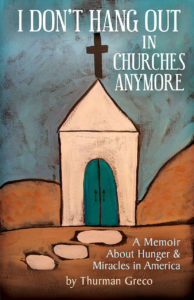
December 9, 2018 at 6:14 pm

Tom Pacheco, a local and extraordinary songwriter and singer/guitarist will perform his annual December Peace Concert along with Brian Hollander at 8:00 pm on Saturday, December 15th at the Rosendale Café, 434 Main Street, Rosendale.
Tom Pacheco is a much loved performer who writes poetically beautiful songs. He tells stories of life in a penetrating style which sends a message about fighting for the truth. He and Brian Hollander have played together many times at concerts in the area.
Tom Pacheco is also a personal hero of mine. His support of the food pantry as we served hungry people went beyond words. On two separate occasions, Tom Pacheco played concerts with all proceeds going to feed hungry people.
The Rosendale Café doesn’t take reservations but serves fine vegetarian food. For more information, see rosendalecafe.com or call 845-658-9048.

Tom has his own chapter in this book because of the work he did to bring food to the pantry to feed the hungry.
Thank you for reading this article. Please refer it to your favorite social media network.
Please tell all your friends, relatives, neighbors about this concert.
Thank you
Thurman Greco
Woodstock, New York
July 15, 2018 at 1:42 pm
Seniors Being Hungry is a Nationwide Epidemic
Nearly one in every six seniors in America faces the threat of hunger and not being properly nourished. This applies to those who aren’t sure where their next meal is coming from and those who don’t have access to the healthiest possible food options. The issue is severe enough that the AARP reports that seniors face a healthcare bill of more than $130 billion every year due to medical issues stemming from senior hunger.
Senior hunger is an expansive issue that requires an understanding of exactly what constitutes a senior being “hungry,” the issues that stem from senior hunger, and how seniors who are hungry can be helped.
To understand the concept of seniors being hungry, you must understand what it means to be “food insecure.” When you are food insecure, it means that there is “limited or uncertain availability of nutritionally adequate and safe foods or limited or uncertain ability to acquire acceptable foods in socially acceptable ways,” as defined by a study published in The Journal of Nutrition. Essentially, it means that you aren’t receiving and/or don’t have access to the necessary foods and nutrients to help sustain your life.
The concept of being “hungry” is a state-of-mind, meaning that there is a physical aspect to the lack of food. Attending to an area where people are hungry and basically starving is a much more immediate and severe problem to solve. Being food insecure, on the other hand, helps include people who may have enough food and don’t technically live consistently in hunger, but the food they are eating—usually in large amounts—isn’t up to nutritional and dietary standards.
In 2006, the USDA broke down food insecurity into two categories to help determine how food insecure someone is:
Of Households In America Are Food Insecure
 Low Food Security
Low Food Security
While there may not be an overall reduction in how much food someone is intaking, there may be a lower quality and variety of your diet. For instance, there may be reduced amounts of fresh vegetables and meats, but that may be replaced with fast food. In this category, people don’t miss many meals, but the type of meals that are being eaten diminish in quality.
 Very Low Food Security
Very Low Food Security
When you have very low food security, your health and ability to correct it with healthy food is in a dire situation. To be assigned this categorization, the USDA says there must be “multiple indications of disrupted eating patterns and reduced food intake,” meaning you’re often missing meals and not eating enough to survive.
The Numbers Behind Senior Hunger
In 2017, there are just more than 49 million Americans age 65 and over, and about 8 million of them can be considered facing the threat of hunger.
Not only is senior hunger such a large issue now, the threat of it persisting as a problem into the future is high because of the high rate of seniors expected to exist. As seniors lost million dollars in the stock market through the 2007 economic recession, their wealth- including retirement funds, insurance payouts, and pension checks – plummeted. This increased the rate at which seniors spent money on lesser quality food in favor of other things like insurance.
In 2014, the National Foundation to End Senior Hunger (NFESH) reported the following facts:
Of seniors “face the threat of hunger,” meaning they’re at some level of food insecurity
Increase in hunger among the senior populations from 2007 to 2014, which is credited partially to the economic recession that started in 2007
Seniors are expected to be in America by 2020, according to the U.S. Census Bureau
Seniors are expected to take up 20% of the population by 2050
Are Some Seniors More Affected than Others?
An even deeper issue with senior hunger, aside from how many seniors it affects, is how disproportionately the food insecurity is spread out amongst race, class levels, and geographic location. Let’s take a look at some of the factors that contribute to how certain seniors are more affected than the others.
CLASS
NFESH performed a deep analysis of the level of food insecurity among seniors in 2008. Within the report is the role seniors’ closeness to the poverty line plays in how food insecure they are, whether they are marginally food insecure, food insecure, or very low food secure. For example, nearly 80 percent of seniors “below 50 percent of the poverty line,” which in 2013 was $15,510 for a two-person household, were at some level of food insecurity.
While food insecurity rates dropped closer to and above the poverty line, the report clarifies that “hunger cuts across the income spectrum.” More than 50 percent of seniors who are at-risk of being food insecure live above the poverty line.
Craig Gundersen, a professor at the University of Illinois and food security expert, says that the main areas where food insecurity is increasing the most is among Americans making less than $30,000 per year and those between the ages of 60 and 69.
Gundersen blames the increase in food insecurity rates to many things, but primarily there was a decrease in wages and overall net worth after the recession in the late 2000s. Many seniors lost mass amounts of money when the stock markets crashed, and as they’re entering retirement, they didn’t have the time to recover. “Most of them can’t rely on Social Security income, and can’t receive Medicare until they are 65,” Gundersen said.
A Census Bureau report from 2011 notes that about 15 percent of seniors (about one in six) live in poverty, based on a “supplemental poverty measure” that adjusts the poverty level to modern day living expenses. This is important because you are more likely to develop an illness like cancer or heart disease—both often linked to your overall health— when you live in poverty.
Of Seniors Who are At-Risk of Being Food Insecure Live Above the Poverty Line
Of the Population Without a Car in Many Southern Counties Don’t Have a Supermarket Within a Mile
RACE
Another issue with senior hunger—and food insecurity in general—is how much race affects the likelihood that you are food insecure. And this is directly tied to class level, as minorities often live in lower income brackets. While the AARP points out that, as you age, the rate of food insecurity raises among all races and ethnicities, there are still those who experience food insecurity at much higher rates.
The aforementioned 2008 report of food insecurity found that African-American seniors were far more likely to have some sort of level of food insecurity than white seniors (almost 50 percent compared to 16 percent) and that Hispanics were more likely to live at some level of food insecurity than non-Hispanics (40 percent compared to 17 percent).
“African-American households are two to two-and-a-half times as likely to be in one of the three categories as the typical senior household,” the report clarified, also noting that Hispanics face similar odds. It’s also more likely in both these minority groups for someone to be food insecure if they are widowed or divorced and live alone.
FOOD DESERTS
As mentioned, there are also certain parts of the country that are more likely to be food insecure than others. Areas where access for fresh produce and food is the most limited are known as “food deserts.” Not only does this include the absence of fresh food, but food deserts also include areas where access to food is inhibited because of the lack of grocery stores or the lack of transportation to get to one.
Food deserts often fall in poorer areas of the country, which further fuels the food insecurity levels due to class.
All but one of the top 10 states for food insecurity are in the South or Midwest. These states match a map of the United States that shows the high concentrations of food deserts. In many of the states with high levels of food insecurity, there are also counties with larger concentrations of areas where there is no supermarket within a mile of people who don’t have a car. For instance, in many counties in Arkansas, Alabama, and Louisiana, more than 10 percent of the population without a car doesn’t have a supermarket within a mile.
This severely affects an individual’s health. Those who lived more than 1.75 miles from a grocery store actually turned out to have a higher body mass index (BMI) than those who lived closer to one, a 2006 study found.
According to the USDA, the states with the highest levels of food insecurity (rates between 20 percent and 30 percent) among elders 60 and older are:
South Carolina
Alabama
Mississippi
New Mexico
Maine
Louisiana
Texas
Arkansas
Missouri
Kansas
The Challenges that Can Cause Senior Hunger
As we’ve seen, there are socioeconomic reasons why a senior may be food insecure, and we just looked at some of the main ones. But there are plenty of other factors that may cause someone to not get the proper food they need to maintain their health:
LIVING ALONE
According to a 2012 report, nearly half of the senior households that experienced food insecurity were those where a senior was living alone. There are many things that living alone can do to spur food insecurity, such as not having someone else to help get food from the store if you’re lacking mobility and cook it for you. Living alone also factors into depression and the development of dementia, both of which have side effects of the suppression of hunger. The NFESH study backs this up as well, noting that “those living alone are twice as likely to experience hunger compared to married seniors.”
AGE
Seniors aged below 70 are more likely to experience bouts of food security than those aged 70 and up. The NFESH report showed that as seniors aged, they were less likely to be any level of food insecure, with those under 70 (20 percent) living at some level of food insecurity than those over 80 (14 percent). This can be attributed to many factors, such as the amount of money received from government programs like Medicare (which help alleviate medical costs so more money can be spent on food) and whether or not they live in an assisted living facility, which may help with more consistent eating habits.
EDUCATION LEVEL
Those with a high school degree or no high school degree at all are more likely to experience some sort of food security than those with a college degree. There is a stark drop off of food insecurity levels with someone who at least has some college education. This can be tied to getting paid higher wages at jobs, which then translates to the potential of having more money saved up when you’re older.
Overall, senior women are slightly more likely to be food insecure than men, but the rates are not vast enough to be a determining factor in the likelihood of food insecurity. All of these factors, though—from the big ones like geographic location and race to the smaller ones like age—play into seniors’ overall health, a detrimental factor to how long seniors will live.
Illnesses Caused by Malnourishment
As seniors become more food insecure, they also become more likely to develop diseases and illness that could cut their life short. Feeding America, a nonprofit organization that focuses on hunger issues across the country, took a look at various illness that were more likely to occur when seniors lived with food insecurity. We’ll dive into those illness—along with a couple more—that can stem from eating poor food and eating at an infrequent rate.
According to a 2017 report from Feeding America, food-insecure seniors are 60 percent more likely to suffer from depression than food-secure seniors. Another study from the AARP determined that food insecure people were nearly three times more likely to suffer from depression.
Some of the leading causes of depression include having conflicts in your interpersonal relationships and life-altering events that completely shift your life, typically trending negative. The inability to provide consistent healthy food for yourself or your family can lead to depression. This is because though you may have once lived food secure, you are constantly worrying about making sure you’re going to have some sort of food on your plate for your next meal. Years of worrying about your next meal can take a toll and put you in a constant depressive mood. If you do suffer from depression, a side effect is a suppressed hunger, and that can further worsen your health—it’s a vicious cycle.
There are many negative effects food insecurity has on the heart, both from a level of stress and other physiological aspects. The Feeding America study found that seniors who suffer from food insecurity were 40 percent more likely to experience congestive heart failure, where the heart ceases pumping blood around the body at a necessary pace. This is a direct result of the quality of food eaten among food-insecure seniors and how lacking the necessary nutrient—especially when older—can play a role in exacerbating dire health issues.
The inconsistency at which food-insecure seniors eat also fuels stress levels that have negative effects on the heart as they’re consistently worrying about their next meal. The American Heart Association notes that prolonged stress can increase your risk of high blood pressure, overeating, and the lack of physical activity—all leading causes of heart disease. So just as the type of food you’re eating can have physical effects, food insecurity can also have psychological and physiological effects because of the situation at hand.
But these heart issues don’t start once you’re older. The Center for Disease Control conducted a 10-year study on 30 to 59 year olds and the relationship between their levels of food security and their heart. The study found that those with very low food security were far more likely to develop a cardiovascular disease that those who were at least marginally food secure. This shows that health problems associated with food insecurity, while prevalent in seniors, can begin with prolonged exposure to food insecurity.
The overall quality of food—and how inconsistently it’s eaten—plays a role in developing type 2 diabetes in seniors.
A 2012 study, which analyzed the role food insecurity plays in cardiometabolic disease (a disease that increases the risk of diabetes), points out that some aspects of food insecurity include binge eating food when it becomes available and eating energy-dense food, which can put an overall unhealthy strain on the heart and contribute to becoming diabetic. In 2013 and 2014 alone, a separate study found that food-insecure seniors were nearly twice as likely to be diabetic than food-secure seniors. Overall, it concluded that food-insecure seniors were 65 percent more likely to be diabetic.
Not only does food insecurity increase the risk of diabetes, it’s also difficult for a diabetic person to afford a diet that supports diabetes when they are food insecure. When concluding that food insecurity is an independent risk factor in developing diabetes, the study said:
“This risk may be partially attributable to increased difficulty following a diabetes-appropriate diet and increased emotional distress regarding capacity for successful diabetes self-management.”
Limited Activities of Daily Living
Food insecurity among seniors generally affects how they can live their day-to-day lives. Sidney Katz, a physician from the mid-1900s, developed the concept of Activities for Daily Living (ADLs) that helps determine how functional an elderly person is and whether or not they are able to support themselves or not. The six detrimental ADLs to an elderly person include:
- Bathing
- Personal hygiene
- Going to the bathroom
- Sleeping on their own
- Mobility (getting in and out of bed, walking, etc.)
- Being able to feed themselves
The presence of food insecurity has been found to negatively affect seniors’ ability to complete these ADLs, which hinders their ability to continue to live on their own. An NFESH study found that food-insecure seniors were 30 percent more likely to report at least one ADL limitation, and this is largely fueled from being unable to physically get to the store and purchase food. This can then affect a senior’s health and take its toll on other ADLs, such as the ability to go to the bathroom on their own.
Organizations Working to End Senior Hunger
There are ways to combat senior hunger, and there are thousands of workers out there to help stemming from non-profit and governmental organizations.
The primary organization you should know about if you’re a food-insecure senior—or suffer from food insecurity at all—is the Supplemental Nutrition Assistance Program (SNAP), also known more commonly as food stamps. SNAP assists low-income citizens with getting the necessary food they need.
As of 2014, it was found that less than 50 percent of the elderly eligible for the program were enrolled, which is a staggeringly low number. The government is willing and able to help seniors suffering from food insecurity. You can visit the benefits website to see if you are eligible for the programs and apply.
There are also organizations seeking to end senior hunger and decrease levels of food insecurity among the senior population. Some of these include the National Foundation to End Senior Hunger, Meals on Wheels and other food delivery services, USDA services, and AARP:
The National Foundation to End Senior Hunger is a large non-profit organization dedicated directly to putting an end to senior hunger. Their vision statement is as follows: “We will identify and assess this challenge in communities through funding senior-specific research, fostering local collaboration and engaging diverse partners. We foresee the creation of tangible, replicable solutions in ending senior hunger to meet the needs of an aging population.”
Government organizations like the USDA started services that bring food to seniors who don’t have the means of getting to a grocery store. There are also organizations like Meals on Wheels that help deliver healthy meals to people of all ages, including seniors.
Healthy Eating Tips to Remember
In addition to looking for assistance from organizations, there are steps you can take when buying your groceries to ensure that the money is spent on the proper healthy foods.
Primarily, you must know what you’re looking for when you enter a grocery store, so it’s important to make a list. This way, you won’t deviate from the plan of buying healthy foods. Make sure to look out for deals on healthy food, and buy multiples of one product if it’s non-perishable so you don’t have to make a trip back for the same deal.
It’s also important to not waste any food. If you are buying vegetables and produce in bulk, put them to use and prepare multiple meals at one time. It’s also perfectly fine to freeze meats for months at a time, so buy a few more pounds than you originally planned and put it in the freezer for several weeks from when you buy it.
You should also know exactly what you’re buying. Make sure to not load up on food that is high in carbohydrates. This can contribute to weight gain and cause you to accidentally skip meals if you are too full from previous meals. You should also compare labels when choosing between products. The products with lower sugar and sodium levels are typically better for you than their counterparts.
With these tips and the information presented above in mind, hopefully we as a society can move closer to ending hunger for seniors and our nation as a whole.
1200 G STREET, NW, WASHINGTON, D.C., 20005
March 21, 2018 at 12:38 am
The world of people who are homeless may seem very foreign – But, it’s actually very near. We meet people every day who are just like us, only they don’t have a roof over their heads.
We can all find ourselves without a roof when we lose a job. Or, maybe a spouse dies. Possibly an accident which leaves physical disabilities is the cause. In short, all it takes is a personal tragedy.
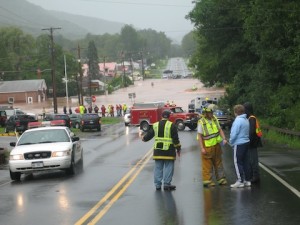 There are many things we can do to help end homelessness. There are many, many things we can do to help those who are struggling with homelessness.
There are many things we can do to help end homelessness. There are many, many things we can do to help those who are struggling with homelessness.
One easy way we can help is to take a little extra food along when we go out of our home to work or on errands. A few extra sandwiches will help. When a person asks for change, offer him or her a sandwich.
A couple of times each year, gather the clothes you are no longer going to wear and donate them to shelters and pantries providing services to help those who are homeless.
While you gather clothes for the homeless, look at your family’s toys, books, and games and select those that are no longer being used. Children living in shelters have few possessions and will enjoy them.
Can you spare an hour or two? Tutors can make all the difference. Volunteer to tutor children in shelters.
Celebrate your birthday or anniversary and ask the people you invite to bring items for the homeless.
Carry fast food certificates with you when you are going out. Hand them out to people who are homeless.
Hold a food drive and take the food to a shelter or a pantry in your area.
Donate your collectable recyclable cans and bottles to people who are homeless. Donate a bag of groceries to a soup kitchen, shelter, or food pantry.
Volunteer at a food pantry or shelter.
Volunteer your professional services. Lawyers, doctors, psychiatrists, counselors, and dentists can all use your skills when you volunteer at a pantry or shelter.
Ask your company, church, school to host a fund-raising event for a pantry or homeless shelter. Items of dignity are really needed by the homeless.
 Thank you for reading this article!
Thank you for reading this article!
Please refer this article to your favorite social media network.
Thurman Greco
PS: The hunger book is really moving along. Things just never get finished as quickly as we all wish. Writing a book requires years and years of research and writing. In writing the hunger book, I have gone through thousands and thousands of sheets of paper and three computers. I have spent years and years getting this story moved from an event in my life to a book which will attract you or not in less than two minutes.
Whew!






 Thank you for reading this article. Please refer it to your preferred social media network.
Thank you for reading this article. Please refer it to your preferred social media network.
















 There are many things we can do to help end homelessness. There are many, many things we can do to help those who are struggling with homelessness.
There are many things we can do to help end homelessness. There are many, many things we can do to help those who are struggling with homelessness. Thank you for reading this article!
Thank you for reading this article!
